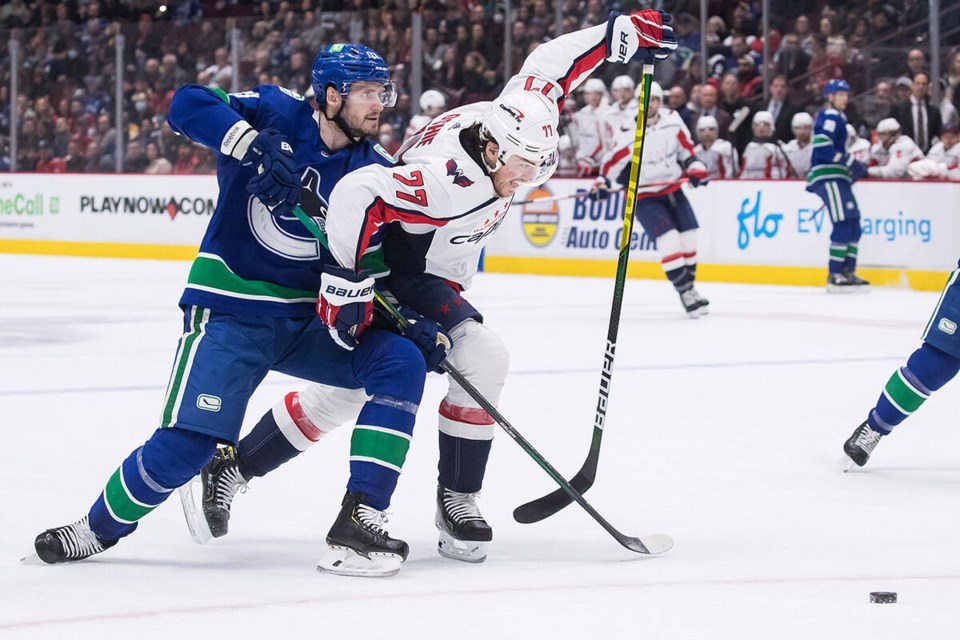Oliver Ekman-Larsson’s time in Ā鶹“«Ć½Ó³»didn’t have to end in a buyout but it was never going to end well.
When people say that the Ā鶹“«Ć½Ó³»Canucks should not have traded for Ekman-Larsson, there’s no hindsight involved. It was blatantly obvious that then-general manager Jim Benning’s pursuit of Ekman-Larsson was foolish right from when he first showed interest a year before a deal was done.
The reasons to avoid Ekman-Larsson from just a hockey standpoint were multifarious. Ekman-Larsson was already 30 years old, with his best years behind him. His underlying analytics had been crashing for years as his mobility declined in the wake of injuries and the eye test wasn’t any kinder. Tracking data showed a player who struggled to transition the puck up ice and was too permissive at the blue line, allowing clean zone entries to his opponents again and again.
For the Canucks, Ekman-Larsson made even less sense. Despite Benning’s claim that Ekman-Larsson would be the team’s number-one defenceman, he wasn’t even the Arizona Coyotes’ number-one defenceman at the time of the trade and the Canucks already had Quinn Hughes.
With Hughes quarterbacking the top power-play unit, there was no opportunity for Ekman-Larsson to make use of one of the few remaining positive aspects of his game: his ability to move the puck and get shots through from the point with the man advantage.
It’s no coincidence that Ekman-Larsson’s first season with the Canucks was the first time in a decade he failed to score at a 40-point pace.
His contract sucked
Those are just the on-ice reasons to avoid Ekman-Larsson. That’s not even considering his contract, the one that led to the most expensive non-compliance buyout in NHL history.
When the trade was made, Ekman-Larsson’s contract with the Coyotes was considered . He had an $8.25 million cap hit for another six seasons — a contract befitting the number-one defenceman Ekman-Larsson once was but a boat anchor for the defenceman he had become.
Due to the shortened seasons at the height of the COVID-19 pandemic, the NHL’s salary cap was going to remain flat for some time, making Ekman-Larsson’s contract even less palatable. Every dollar counted and paying top-pairing defencemen dollars to a player who had played like a replacement-level defenceman just didn’t make any sense.
Ekman-Larsson’s contract was an albatross, the type of contract that typically only gets traded as a salary dump — giving a team assets to take on a player’s cap hit.
A top-ten pick for a salary dump
Instead, the Canucks paid a premium asset — a top-ten draft pick — as well as a second-round pick and a seventh-round pick to acquire Ekman-Larsson and winger Conor Garland.
Garland was a solid piece — a legitimate top-six winger with excellent 5-on-5 production — but he was not worth either a top-ten pick or taking on the remainder of Ekman-Larsson’s contract, let alone both. As Ekman-Larsson got bought out, rumours have swirled that other teams won’t take on Garland’s contract without a sweetener: in other words, a salary dump.
That top-ten pick — ninth overall — was used on Dylan Guenther, who put up 45 goals and 91 points in 59 WHL games in his post-draft year. He made his NHL debut last season at 19 years old and put up a solid 15 points in 33 games with the Coyotes.
Impatience and short-term thinking
Those weren’t the only pieces involved in the trade, of course. The Canucks also dumped a bit of salary of their own, sending Antoine Roussel, Jay Beagle, and the much-maligned Loui Eriksson to the Coyotes. The difference between those three bad contracts and that of Ekman-Larsson is that those three contracts only had one year remaining.
The Canucks could have waited one more season and just let the Roussel, Beagle, and Eriksson contracts expire, giving them oodles of cap space to upgrade the roster in a multitude of ways. But short-term thinking aimed at getting the Canucks back to the playoffs in a hurry — the same short-term thinking that plagued every Canucks offseason under Benning — meant those three bad contracts became one big boat anchor for years to come.
The trade was an utter disaster for the Canucks right from day one. Ekman-Larsson was a detriment on the ice, a salary cap quagmire off the ice, and cost the Canucks a premium asset to acquire.
It’s not the least bit surprising that Ekman-Larsson's time in Ā鶹“«Ć½Ó³»ended with him being a healthy scratch and getting bought out. It's maybe a bit surprising that it only took two seasons — two seasons in which the Canucks missed the playoffs by a wide margin.
Now, Benning’s boondoggle will cost the Canucks against the salary cap for another eight years, as the buyout will be on the books through 2031.


